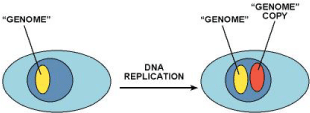
| MadSci Network: Genetics |
Rajesh:
Sister Chromatid Exchange, or SCE, is the exchange of homologous stretches of DNA sequence between sister chromatids. First, let’s examine why this happens, then we’ll talk about the mechanism of SCE.
SCE occurs normally in cells during mitosis, or cell division, but when a cell’s DNA is damaged by genotoxic agents, the rate of SCE increases. It is thought that SCE is an attempt by the cell to fix the DNA damage caused by genotoxic agents; therefore, you would expect a more potent genotoxic agent to generate a higher rate of SCE.
While DNA damage-repair pathways are usually quite efficient, too many damage events will cause a cell to give up and die. That is, after a certain point, the cell is unwilling or unable to try and fix all of the damage. Here’s another way to think about it: If you wrecked you car, would you want to fix it? If the car sustained only minimal damage, then you probably would try to repair it. But if the damage is extensive, then you might think it’s not worth the effort to save the car -- or even if you think it's worth it, you might not be able to. That is very similar to the "reasoning" process the cell uses to decide whether to try to fix its damaged DNA.
Altogether, this suggests that genotoxic agents that inflict large amounts of DNA damage on a cell – causing the highest SCE rates – will be more apt to kill cells. As a result, they will likely be regarded as promising candidates for use in the treatment of cancers.
What is the mechanism of SCE?
We’ll answer this question first by asking, “What is a sister chromatid?” You probably know that before a cell can divide, it has to replicate its DNA, generating two complete sets of its genome. (In humans, a complete genome consists of 2 pairs of 23 chromosomes, 46 chromosomes in all. DNA replication would generate two complete sets of 46 chromosomes, for a total of 92 chromosomes.)

Sister chromatids come in pairs, consisting of one original chromosome and its identical copy, generated during DNA replication.
Sister chromatid exchange occurs during mitosis, when condensed sister chromatids pair up. Identical DNA sequences are lined up next to each other and traded between the two chromosomes. The molecular mechanism for this process is not clear, but some reports suggest that it is executed by a "homologous recombination" DNA repair pathway.

To see a nice picture of mutliple SCE events visit this page.
You also might ask, "Why do genotoxic agents target tumor cells specifically?" Can you come up with an explanation for why tumor cells would be more vulnerable to genotoxic agents than the non-cancerous cells surrounding the tumor, or other cells in the body? Hint: what is the primary difference between tumor cells and normal cells?
Jennifer Logan
Genetic Science Learning Center
Eccles Institute of Human Genetics
University of Utah
Try the links in the MadSci Library for more information on Genetics.